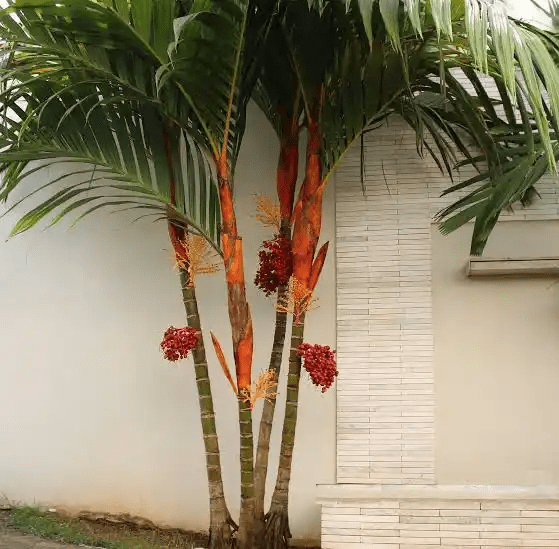The Orange Crownshaft Palm (Areca vestiaria) is a distinctive and visually captivating palm species native to Indonesia. It is known for its vibrant appearance, particularly its orange crownshaft, which makes it a popular choice for ornamental landscaping.
The Orange Crownshaft Palm features a slender, solitary trunk that can reach a height of about 10 to 15 feet (3 to 4.5 meters). The trunk is typically grayish in color and has a smooth texture.
The palm’s leaves are pinnate, which means they are feather-like and arranged along the stem. Each leaf can grow to a length of approximately 6 to 8 feet (1.8 to 2.4 meters). The leaflets are numerous and arranged in a fan-like manner along the central axis of the leaf.
The most distinctive feature of this palm is its crownshaft. The crownshaft is the area just below the base of the leaves, where the leaves emerge from the trunk. In the case of the Orange Crownshaft Palm, this crownshaft is a brilliant orange color, which sets it apart from many other palm species.
The name Orange Crownshaft Palm is derived from the palm’s vivid orange crownshaft. This vibrant coloration contrasts beautifully with the green foliage and the grayish trunk, making the plant a striking focal point in gardens or landscapes.
Areca vestiaria is native to certain regions of Indonesia, particularly in areas with tropical climates and ample rainfall. It thrives in well-drained soils and prefers partial to full sunlight.
The Orange Crownshaft Palm is primarily cultivated for its aesthetic appeal. Its unique and eye-catching appearance makes it a popular choice for ornamental gardens, parks and tropical landscapes.
The Botanical Description of Orange Crownshaft Palm
1. Life: The Orange Crownshaft Palm, scientifically known as Areca vestiaria, belongs to the family Arecaceae. This striking palm is characterized by its vibrant orange crownshaft, which sets it apart from other palm varieties. The life of an Orange Crownshaft Palm starts as a seed, growing into a stunning ornamental plant with lush fronds and a unique crownshaft structure.
2. Appearance: The Orange Crownshaft Palm boasts an elegant appearance, featuring pinnate leaves that can reach lengths of several feet. The crownshaft, a distinctive part of the plant, exhibits a vivid orange hue, adding a splash of color to its overall aesthetic. The fronds are arranged in a graceful pattern, creating a visually appealing display.
3. Growth Pattern: This palm follows a moderate growth pattern, making it suitable for both indoor and outdoor cultivation. Understanding the growth stages, from seed germination to maturity, is crucial for those looking to cultivate and care for an Orange Crownshaft Palm.
4. Reproductive Characteristics: The reproductive cycle of the Orange Crownshaft Palm involves the production of flowers and subsequent fruit development. Delving into the specifics of its reproductive characteristics provides valuable insights for botanists and enthusiasts alike.
The Geographic Distribution of Orange Crownshaft Palm
1. Native Habitat: The Orange Crownshaft Palm is native to specific regions, primarily found in the tropical rainforests of Papua New Guinea and surrounding areas. Exploring its native habitat sheds light on the environmental conditions that favor its growth.
2. Climatic Preferences: Understanding the climatic preferences of the Orange Crownshaft Palm is essential for successful cultivation. This palm thrives in tropical climates with consistent warmth and humidity. Insights into its climatic requirements contribute to effective landscaping and horticulture practices.
3. Global Cultivation: Due to its ornamental appeal, the Orange Crownshaft Palm has transcended its native habitat and is now cultivated globally. Exploring the regions where it has been successfully introduced provides a broader perspective on its adaptability and popularity.
The Chemical Composition of Orange Crownshaft Palm
1. Nutritional Components: Analyzing the chemical composition of the Orange Crownshaft Palm involves identifying its nutritional components. From essential minerals to vitamins, understanding the nutritional value of this palm contributes to its potential benefits, whether in landscaping or traditional medicine.
2. Unique Compounds: The Orange Crownshaft Palm may contain unique compounds that contribute to its distinct characteristics. These compounds could have potential applications in various industries, such as cosmetics or pharmaceuticals. Examining these compounds offers opportunities for further research and development.
3. Resilience and Adaptability: Exploring the chemical composition also sheds light on the palm’s resilience and adaptability to different environmental conditions. This knowledge is valuable for researchers and cultivators aiming to enhance the resilience of crops in the face of climate change and other challenges.
Read Also: 8 Medicinal Health Benefits of Brahma Kamal (Saussurea obvallata)
The Medicinal Health Benefits of Orange Crownshaft Palm (Areca Vestiaria)

Here are 9 common medicinal health benefits associated with orange crownshaft palm along with related examples:
1. Skin Health: Orange crownshaft palm products have been used topically to moisturize and soothe the skin, potentially benefiting conditions like dryness and irritation.
2. Digestive Health: Certain palm fruits are consumed for their potential digestive benefits, aiding in digestion and promoting gut health.
3. Antioxidant Properties: Some palm species contain compounds with antioxidant properties that can help neutralize harmful free radicals in the body.
4. Wound Healing: Certain parts of the tree have been used in traditional medicine for wound healing due to their potential antiseptic and healing properties.
5. Anti-Inflammatory Effects: Orange crownshaft palm extracts have shown anti-inflammatory potential in research studies, which could be beneficial for conditions involving inflammation.
6. Potential Immune Support: Compounds found in these plants might have immune-modulating effects helping to support the body’s immune response.
7. Nutritional Value: Orange crownshaft palm fruits and parts will offer essential vitamins, minerals and nutrients that contribute to overall health and well-being.
8. Cardiovascular Health: Some palm products have been investigated for their potential to support heart health by influencing cholesterol levels and improving blood circulation.
9. Traditional Uses: In some cultures, palm species have been used in traditional medicine for a range of purposes including treating ailments like fever, pain, and infections.
The Methods of Usage to Achieve the Provided Health Benefits of Orange Crownshaft Palm (Areca Vestiaria)
1. Topical Use: For skin conditions, palm-based preparations could be applied topically. Leaves, fruits, or extracts might be used as poultices, creams or ointments. To prepare a poultice, you might crush or grind parts of the plant and apply the paste directly to the affected area. Cover with a clean cloth or bandage.
2. Infusions and Teas: Leaves or other plant parts could be infused in hot water to create teas. This method is often used to extract water-soluble compounds from the plant. To prepare an infusion, pour hot water over the desired plant parts, let steep for a few minutes, and then strain before drinking.
3. Decoctions: Harder plant parts like bark or roots are often used in decoctions. This involves boiling the plant material to extract its beneficial compounds. To prepare a decoction, place the plant parts in cold water, bring to a boil, and then simmer for a certain period of time. Strain before consuming.
4. Tinctures: Tinctures involve using alcohol or another solvent to extract the active compounds from plant material.To prepare a tincture, the plant parts are soaked in alcohol for a specific period, and then the liquid extract is strained and used in small amounts.
5. Powders and Capsules: Orange crownshaft palms are dried and ground into powders, which can then be encapsulated or added to food or beverages. To prepare a powder, dry the plant material thoroughly and grind it into a fine consistency using a mortar and pestle or a grinder.
6. Steam Inhalation: For respiratory issues, steam inhalation with orange crownshaft palm extracts could be considered. Add palm leaves or extracts to a bowl of hot water, lean over the bowl, cover your head with a towel, and inhale the steam.
The Side Effects of Using Orange Crownshaft Palm Medicinal Plant
When considering using orange crownshaft palm medicinal plant for medicinal purposes, it is essential to exercise caution and keep the following points in mind:
1. Allergies: Some individuals may have allergies or sensitivities to certain plants, including palms. Skin reactions or respiratory issues could occur if you are allergic to any components of the plant.
2. Toxicity: Certain parts of the plant, including leaves, stems or seeds can contain compounds that are toxic if ingested or come into contact with the skin. Even if a plant is not commonly known to be toxic, it’s important to exercise caution.
3. Interactions: If you’re taking medications or have existing health conditions, there’s a possibility of interactions between plant compounds and your medications. Consult with a healthcare professional before using any plant-based remedies.
4. Pregnancy and Nursing: Pregnant or breastfeeding individuals should be especially cautious when considering any herbal remedies, as certain plants can affect hormonal balance or have unknown effects on the developing fetus or nursing child.
5. Dosage: Even if a plant has potential medicinal benefits, using excessive amounts can lead to adverse effects. Always follow recommended dosages and guidelines from trusted sources.
6. Individual Variability: People’s reactions to orange crownshaft can vary widely. What works well for one person may not work the same way for another, and adverse reactions can occur unpredictably.
7. Lack of Clinical Trials: The absence of rigorous scientific studies on a specific plant’s medicinal effects means that potential side effects might not be well-documented.
Read Also: 10 Medicinal Health Benefits of Acalypha integrifolia (Acalypha Indian Nettle)
The Scientific Research and Studies of Crownshaft Palm (Areca vestiaria)

1. Morphological and Anatomical Analysis: Scientific examination of the morphological and anatomical features of Crownshaft Palm, providing insights into its structure and growth patterns.
2. Ecological Impact and Habitat Preferences: Research focused on the ecological impact of Crownshaft Palm, including studies on its habitat preferences, contribution to biodiversity, and potential ecological significance.
3. Propagation and Cultivation Techniques: Investigations into effective propagation and cultivation techniques for Crownshaft Palm, aiming to support sustainable horticulture practices and conservation efforts.
4. Genetic Diversity and Conservation Genetics: Studies assessing the genetic diversity of Crownshaft Palm populations, with a focus on conservation genetics to guide efforts aimed at preserving the species.
5. Landscape and Ornamental Use: Research on the landscape and ornamental use of Crownshaft Palm, examining its aesthetic qualities, adaptability to different environments, and potential in landscaping.
6. Phytopathological Studies: Scientific analysis of diseases and pathogens affecting Crownshaft Palm, contributing to the development of strategies for disease management and maintaining plant health in cultivation.
Safety Precautions and Recommendations In Using Crownshaft Palm Medicinal Plant
1. Identification and Authentication: Ensure accurate identification to prevent misusage. Consult a botanist or reliable resources.
2. Dosage and Administration: Follow recommended doses strictly to avoid adverse effects or toxicity.
3. Consultation with Healthcare Professionals: Seek advice before use, especially if pregnant, nursing, or with pre-existing conditions.
4. Potential Interactions: Be aware of interactions with other medications or supplements to prevent adverse reactions.
5. Harvesting Ethics: Harvest sustainably, respecting conservation guidelines and legal regulations.
6. Allergic Reactions: Monitor for skin irritation, respiratory or digestive issues; discontinue if any adverse symptoms occur.
FAQs About Crownshaft Palm Medicinal Plant
1. What are the Common Uses of Crownshaft Palm in Medicine?
Crownshaft Palm is traditionally used for digestive issues, skin health, and respiratory conditions.
2. Can Crownshaft Palm Be Used During Pregnancy?
Consult your healthcare provider for guidance due to potential individual variations in reactions.
3. Are There Any Known Side Effects of Crownshaft Palm?
Generally well-tolerated in moderation; excessive consumption may cause nausea or diarrhea.
4. How Should Crownshaft Palm Extracts Be Stored?
Store in a cool, dark place to maintain potency; avoid direct sunlight to prevent degradation.
5. Can Crownshaft Palm Interact with Prescription Medications?
Inform your healthcare provider about all medications to prevent potential interactions and ensure safety.
Read Also: A Comprehensive Guide to Recycling Benefits





